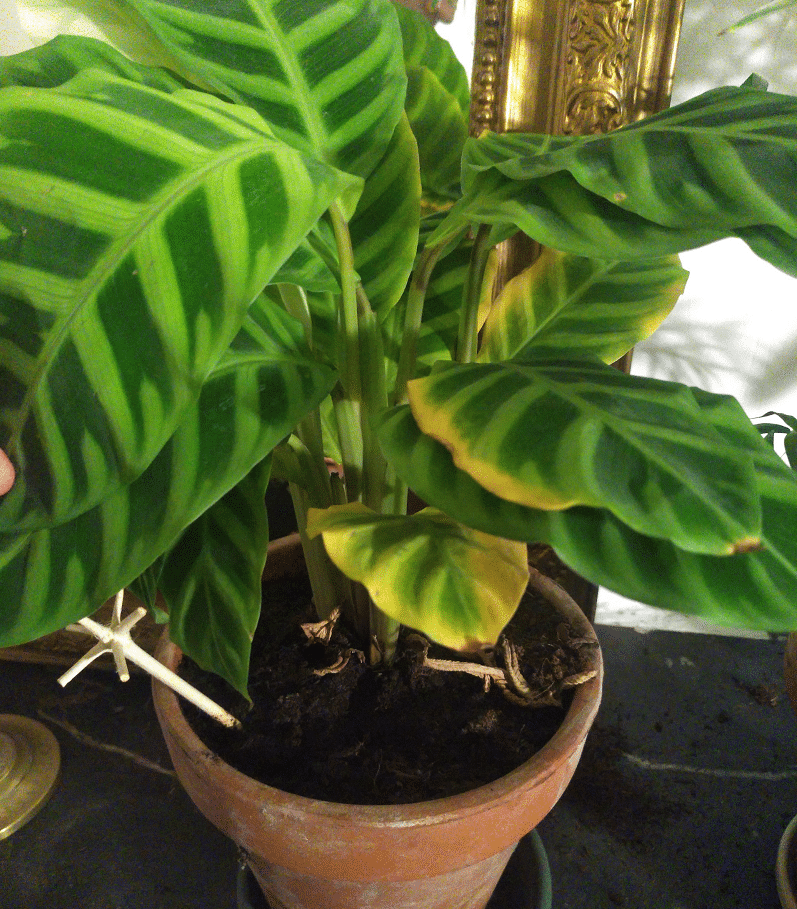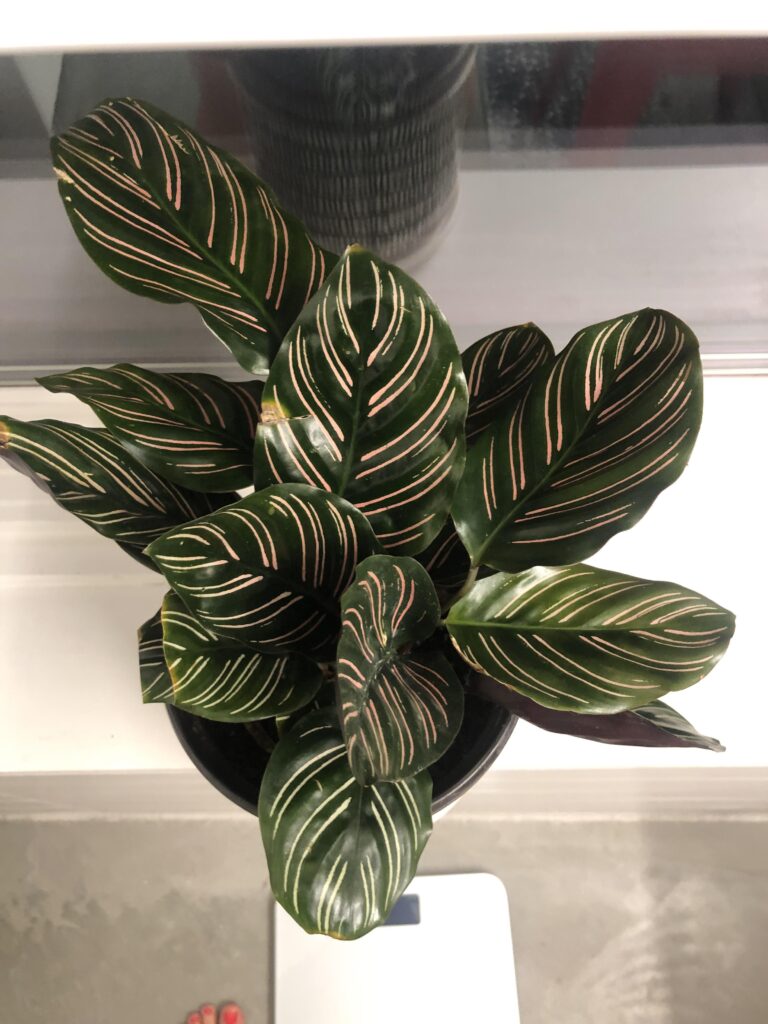Calatheas are the most beautiful houseplants with vibrant foliages. They are perfect for decorating any interior space due to their tropical vibes.
But these indoor plants are super dramatic. If they aren’t getting ultimate care, they’ll express their discontent fast via those stunning leaves.
So, why are my calathea leaves turning yellow? Calathea leaves turning yellow is due to the improper watering regime, extreme temperatures, acclimation issues, old foliages, pests, nutritional deficiencies, lighting problems, and more.
Keep reading to find detailed information about these causes and learn how to fix the problems without compromising plant health.
You May Also Like: How to Care for Calathea Orbifolia Plant

Causes of Calathea Leaves Turning Yellow (And How to Fix)
Calathea plants need ultimate care to make a bold statement. Calathea leaves turning yellow can be nerve-wracking despite providing optimal care.
Calathea orbifolia yellow leaves are a common phenomenon. It is a sign of distress and can happen on any part of the leaf (edges, tips, and all over).
But calatheas are more forgiving after solving the underlying condition. New gorgeous foliages will sprout and restore your plant to normal.
If you notice your calathea leaves turning yellow and brown, examine it and try to trace the cause. The technique will help you correct any errors in care without going overboard.
Below are the most common reasons why your calathea leaves are turning yellow. Take the time to read through and learn how to fix them.
Overwatering Issue
Overwatering is the leading cause of calathea leaves turning yellow. These houseplants prefer consistent watering and slightly moist soil.
The damp environment creates a favorable condition for bacteria and fungi to thrive. These microbes later result in root rot disease.
The damaged roots limit water and mineral absorption. Calathea leaves turning yellow is an initial sign of overwatering.
Be sure to check the soil moisture content and examine the plant roots. If the roots are mushy with brown patches, it is an indicator of root rot.
Consider re-potting the houseplant to save it from dying in the long run. Use well-drained potting mix and a pot with drainage holes at the bottom.
Water the plant when the top half-inch soil feels dry. Develop a consistent watering habitat to avoid issues related to overwatering and under-watering.
Inappropriate Lighting Condition
Calathea plant thrives under medium to bright indirect sunlight. The lighting condition enables the houseplant to produce beautiful and vibrant leaves.
Low lighting conditions will make the leaves of your favorite plant turn yellow. Besides that, direct sunlight exposure will cause severe damages to the stems and leaves.
If you notice the calathea leaves turning yellow, shift the current position of the plant. Relocate the plant to a region that receives bright indirect sunlight.
Install LED Grow Lights if the room does not receive plenty of natural light. It will help to prevent the yellowing of leaves.
Temperature Fluctuations
Calatheas love a temperature range of 62-81oF (16-27oC). The ideal temperature helps to facilitate better plant growth and health.
The houseplant will become unhappy when the temperature is below 62oF. Calathea plants don’t tolerate freezing temperatures. You’ll notice the leaves of your plant starting to turn yellow.
Besides that, calatheas do not like radiating heat and cold drafts. It is one of the reasons why the houseplant struggles during winter.
Be sure to keep your calathea plant away from cold drafts and radiators. Ensure the indoor temperature is constant and meets the plant care requirement.
Lack of Humidity
Calathea plants thrive in a warm and humid environment. These indoor plants are used to the 90% humidity range. But replicating the exact humidity level in the house can be challenging.
The leaves on the calathea plant turn yellow due to low humidity. The phenomenon occurs due to dry air around the plant that fosters rapid water loss.
Use an electric humidifier to help maintain the optimum humidity level in the house. High humidity enables the calathea plant to bring out a tropical vibe.
Fertilization Problems
Calathea plants aren’t heavy feeders. But these plants need nutrients to facilitate the development of stunning and vibrant leaves.
Too much fertilizer will make your calathea leaves start turning yellow. The salt buildup around the root system tends to become toxic to the plant.
The best option is to use organic fertilizer rather than artificial fertilizer. The compost usually mimics the native habitat of the plant.
Be sure to apply fertilizer to calatheas during spring and summer. It is a period where the houseplant will utilize the nutrients to the fullest.
I recommend using slow-release fertilizer rich in nutrients and minerals. Do not apply fertilizer to the plants during winter since they’re dormant.
Pest Infestations
Calathea leaves are more vulnerable to insect infestations. Spider mites, aphids, and scales are the most common pests attacking the calathea plant.
These insects usually pierce the leaves and damage vital tissues. The calathea leaves begin to turn yellow when trying to heal from the damages.
Always use insecticides to get rid of these insects on the leaves. Be sure to perform frequent checks on the leaves to spot these pests at an early stage.
You May Also Enjoy: How to Care for Calathea Musaica

Under-Watering
Calathea plants require a consistent watering routine. Dry soil due to neglect for a couple of months will make the houseplant fussy.
The drought stress also makes the calathea leaves turn yellow. You’ll also notice signs of leaves drooping and curling in the long run.
Be sure to investigate the potting mix moisture before hydrating the plant. The tip will help to avoid overwatering issues from happening.
Calathea plants usually need a lot of watering during summer and fall. Consider watering the plant every two weeks a month. Water the houseplant once a month during winter.
Acclimation Issue
The first day I brought my calathea plant at home, I fall in love with it. I did everything right to keep the plant in better health. But the leaves started to turn yellow after a couple of days.
I came to understand that the houseplant is trying to adapt to my indoor growing condition. These leaves turning yellow issue is usually short-lived.
Always double-check your calathea plant care routine before allowing the plant to adjust to the new environment. Do not neglect the plant at all during this period.
Transplant Stress
Re-potting calathea plants can be challenging for many people. Any slight changes to their growing condition might ruin their well-being and growth.
The good news is that calathea plants are slightly root-bound. You’ll need to transplant the houseplant every two years.
If you notice your calathea leaves turning yellow after re-potting, it is a sign that the plant is trying to acclimate to the new environment.
Aging Leaves
Aging in plants and animals is inevitable. Every plant will shed old lower leaves as it grows. If you notice a mature leaf deteriorating, consider removing it from the plant.
Old leaves on calathea plants are usually yellow and end up falling off after some time. It is a mechanism that allows the houseplant to redirect energy and nutrients to new growths.
You May Also Like: 15 Best Calathea Varieties with Pictures and Names
Frequently Asked Questions
Why Are My Calathea Leaves Turning Brown and Crispy?
It occurs due to low humidity and dry soil. Consider cutting off the affected bits and increase the humidity level. Water the plant more consistently to prevent the soil from drying out.
Why Does My Calathea Leaves Have Yellow Spots?
It is a sign of insect infestations. These pests usually pierce the leaves to suck nutrients and cause some severe injuries. The leaf spots end up turning yellow due to the venom injection.
Why Are My Calathea Leaves Turning Yellow and Curling?
Possible causes are low humidity, overwatering, and pest infestations. It would be best to identify the underlying cause before taking appropriate action.
Why Is My Calathea Leaves Turning Brown?
Direct sunlight exposure and low humidity are responsible for calathea leaves turning brown. These tropical plants thrive in medium to bright indirect sunlight and a high humidity environment.
Why Are My Calathea Leaves Fading?
Calathea leaves fade due to prolonged exposure to excess sunlight. I recommend placing the houseplant in an area with more shade to prevent the leaves from fading.

In Conclusion
Calathea leaves turning yellow is due to inappropriate plant care. It is a common leaf problem that every houseplant enthusiast needs to be aware of it.
The common causes of calathea leaves turning yellow are overwatering, under-watering, nutritional deficiencies, low humidity, pests, and diseases (Source: University of Florida).
Be sure to examine the underlying issue and undertake appropriate action to resolve the leaves from turning yellow.
